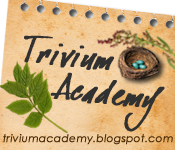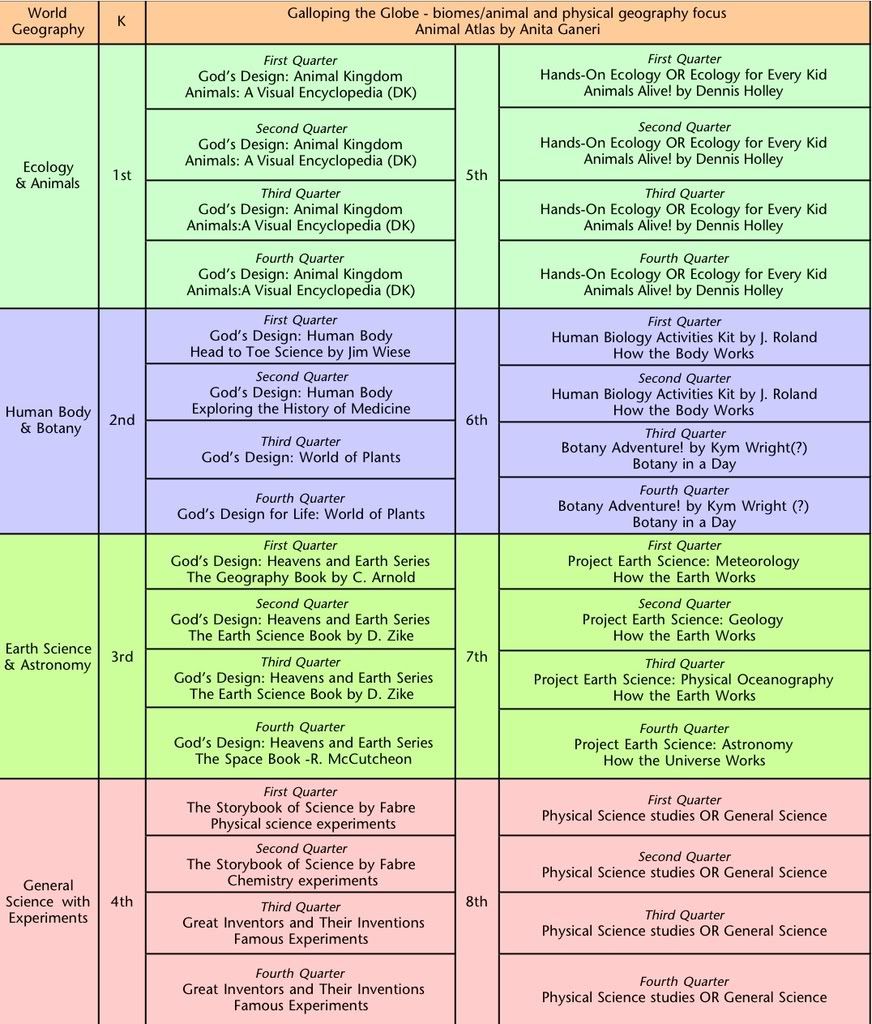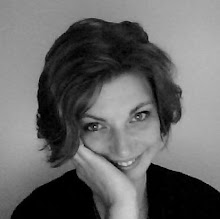Trivium Academy Science K-12
Our year is organized into four quarters, the quantity of resources may reflect that our studies change by quarter. Studies are done year-round from 40-45 weeks. Resources may change as the need changes. It is impossible to list all the resources we might use from the library or other sources throughout each year, this is an overview.

 Kindergarten: We will explore the world with Galloping the Globe and use The Animal Atlas to help visually identify animals within their biomes. Culture, world geography (including introducing landforms), literature and science will be the year’s focus.
Kindergarten: We will explore the world with Galloping the Globe and use The Animal Atlas to help visually identify animals within their biomes. Culture, world geography (including introducing landforms), literature and science will be the year’s focus.We will also start reading Mother West Wind stories or The Burgess Animal Book for Children (depending on interest) as our living science book focus for kindergarten and participate in regular nature walks and studies. First Grade: Our study of animals will deepen and become more organized with the help of God’s Design for Life: The Animal Kingdom and our carefully selected animal encyclopedia, The Encyclopedia of Animals: A Complete Visual Guide by George McKay to help us discover and learn about the animals of our world.
First Grade: Our study of animals will deepen and become more organized with the help of God’s Design for Life: The Animal Kingdom and our carefully selected animal encyclopedia, The Encyclopedia of Animals: A Complete Visual Guide by George McKay to help us discover and learn about the animals of our world.
Danny’s first grade year will be Camille’s fifth grade year so he will have the opportunity to see many animals live and up close as we will be observing many live animals during the course of the year in effort to learn from them.
We will also be reading from our vast home library of animal books as we go through the God’s Design lessons.
For our living science book, we will read either Burgess Animal Book for Children or Burgess Bird Book for Children, as well as James Herriott’s Treasury for Children and our regular nature walks and studies. Second Grade: Studies will continue to be organized by God’s Design for Life series by using The Human Body volume, which will be supplemented with Head to Toe Science by Jim Wiese where appropriate with other science books to expand on the topics we cover.
Second Grade: Studies will continue to be organized by God’s Design for Life series by using The Human Body volume, which will be supplemented with Head to Toe Science by Jim Wiese where appropriate with other science books to expand on the topics we cover. We will use the Magic School Bus World of Germs kit to explore more about germs, bacteria and viruses.
We will use the Magic School Bus World of Germs kit to explore more about germs, bacteria and viruses. John Hudson Tiner’s Exploring the History of Medicine will be read to explore scientists biographies for scientific literacy with DK Eyewitness Medicine. We will use Spotlight in Science’s Famous Experiments kit alongside the History of Medicine, aligning them when possible.
John Hudson Tiner’s Exploring the History of Medicine will be read to explore scientists biographies for scientific literacy with DK Eyewitness Medicine. We will use Spotlight in Science’s Famous Experiments kit alongside the History of Medicine, aligning them when possible. From our study on medicine will start our Botany studies using God’s Design for Life: The World of Plants and Shanleya’s Quest by Thomas Elpel. We have many living science books for botany including Margaret Morley’s Seed-Babies and Gregor Mendel: The Friar Who Grew Peas.
From our study on medicine will start our Botany studies using God’s Design for Life: The World of Plants and Shanleya’s Quest by Thomas Elpel. We have many living science books for botany including Margaret Morley’s Seed-Babies and Gregor Mendel: The Friar Who Grew Peas.
We will also be exploring botany science topics with these 17 creative experiments with three kinds of plants. You'll find out about circadian movements, root structure, phototropism, photosynthesis, growing methods, and more. This kit is ideal for science fairs! It includes seeds (mustard, cactus, and sensitive plants), biodegradable cups, germination discs, water retention crystals, a study guide, and other items.
Also nature walks and studies will continue.
Third Grade: We will use the whole God’s Design for the Heavens and Earth series during the year supplementing with The Earth Science Book by Dinah Zike, The Geography Book by Caroline Arnold and The Space Book by Marc McCutcheon which was used in Camille’s earth science year.
We will read from our home library of wonderful books about rocks and minerals, weather and other earth science topics. Our living science book will be The Fairy-Land of Science by Arabella Buckley.
We will reuse resources that we used for Camille’s year of earth science, including Slinky Science’s Rocks and Minerals kit as well as the Awesome Forces of God’s Creations DVDs.
Nature walks & studies will continue.
 Fourth Grade: This year we will explore topics as they interest us as we read The Storybook of Science by Jean Henri Fabre. Topics range from ants to metals.
Fourth Grade: This year we will explore topics as they interest us as we read The Storybook of Science by Jean Henri Fabre. Topics range from ants to metals.
At this stage in our studies, I prefer to have a textbook to refer to, I have chosen the McDougal/Littel Life Science, Earth Science and Physical Science textbooks.
 Fifth Grade: Animals Alive! by Dennis Holley will lead us through inquiry and observational studies of animals by phylum for an in-depth study . Ecology for Every Kid by Janice VanCleave will be used for ecology as well as a large range of children’s science books to explore the topics further.
Fifth Grade: Animals Alive! by Dennis Holley will lead us through inquiry and observational studies of animals by phylum for an in-depth study . Ecology for Every Kid by Janice VanCleave will be used for ecology as well as a large range of children’s science books to explore the topics further. This year will exciting yet extensive as we keep and observe live animals for a short time to learn more.
This year will exciting yet extensive as we keep and observe live animals for a short time to learn more.
We might get Exploring Ecology by Patricia Warren for our nature studies.
Nature walks & studies will continue. Sixth Grade: We will study the human body in more depth with Human Biology Activities Kit by John Roland with a nonfiction resource (yet to be chosen) such as How the Body Works, or another Human Body encyclopedia in addition to a life science textbook.
Sixth Grade: We will study the human body in more depth with Human Biology Activities Kit by John Roland with a nonfiction resource (yet to be chosen) such as How the Body Works, or another Human Body encyclopedia in addition to a life science textbook.
At this stage we will use a compound microscope, National Optical 131 compound microscope. (selection may change). For our botany studies this year, we will use Botany in a Day by Thomas Elpel with Plant Identification and Terminology and Wisconsin Fast Plants experiments. We will use our life science textbook and the Essential Atlas of Botany to guide our academic learning.
For our botany studies this year, we will use Botany in a Day by Thomas Elpel with Plant Identification and Terminology and Wisconsin Fast Plants experiments. We will use our life science textbook and the Essential Atlas of Botany to guide our academic learning.
Coursework may be modified. Nature studies will continue. Scientists biographies will be chosen for independent reading. Seventh Grade: Project Earth Science titles: Geology, Oceanography, Astronomy and Meteorology will lead our studies for earth science and astronomy.
Seventh Grade: Project Earth Science titles: Geology, Oceanography, Astronomy and Meteorology will lead our studies for earth science and astronomy.
Our academic studies will be supplemented with an earth science textbook and a chosen encyclopedia such as How the Earth Works or How the Universe Works. This may be modified.
The order of study will be Meteorology, Geology, Oceanography and finally Astronomy to finish the year.
Nature studies will continue.
Eighth grade: This year is being reserved as a year to either accomplish high school chemistry or high school biology depending on the math level that is obtained. Scientfic literacy will be an important element. General Science coursework in physical science and chemistry may also be explored. Coursework is to be determined as we near this stage, dependent on skill level, interest and dedication. Possible coursework is as follows:
Option 1: General science coursework with scientific literacy, preparing for high school work.
9th: HS Biology
10th: HS Chemistry
11th: HS Physics
12th: Optional AP coursework or study in field of interest
Option 2: High school biology or chemistry with scientific literacy.
9th: Chemistry/Biology (depending on 8th grade choice)
10th: Physics
11th: AP Biology
12th: Optional coursework depending on interest.
Option 3: Scientific literacy with main focus on mathematical learning.































4 comments:
Two things kind of jumped out at me. One is that for K you are focusing mainly on weather. I would suggest you could go along with the summer theme for the other grades and do a general "animals" theme.
The second is probably just my ignorance showing, but I wouldn't see the need for astronomy every year through grade 8. You did a good job for the other science themes in breaking down which aspect you would cover though, so maybe you already have this in your head and just hadn't written it down.
Anyway, I really like your blog. Thanks for your ideas and insights.
Both plans are great! I like the Old Plan better because I am wondering if the units would be too long. I know personally we would not be able to spend 4 months on the human body..even if there is lots of numerous subjects to cover. We do TOG as well and even though we enjoy the units we are defenintly ready to move onto something else at the end of the 9 week quarter!! So for that reason I like your original plan better. It is very nicely organized giving a good chunk of time to various science topics. Of course this is an age old debate that all families have to decide for themselves. Do you spend one year on one type of science or do you split it up into different science topics!! Everyone seems to be different.
Missed you this weekend!
-D
I don't know about your area but our local hospitals gives CPR classes to pre-teens and teens. That would be a great add-on to your life science in the upper years. My dh is a CPR instructor and we are planning to do the same with all of our dc. I know some mom's
incorporate it with health. It's always great to know CPR.
Post a Comment